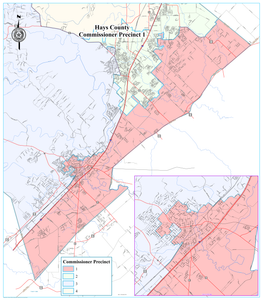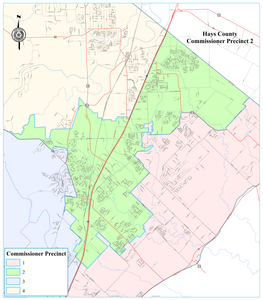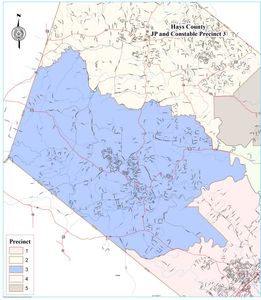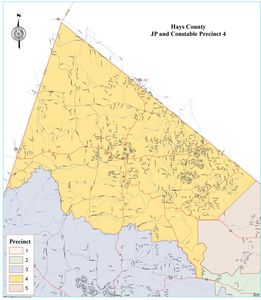Welcome TO HAYS COUNTY!
Hays County is located in Central Texas. It was established in 1848. Our County Seat is San Marcos. Visit this
page
to learn more about us.
ALERTS: For information on measles, visit our Current Public Health Situations page.
Social Media Links:

Announcements

NOTICE OF INTENTION TO ISSUE HAYS COUNTY, TEXAS COMBINATION TAX AND REVENUE CERTIFICATES OF OBLIGATION NOTICE IS HEREBY GIVEN that on January 20, 2026, at 9:00 a.m. at a regular meeting of the Commissioners Court of Hays County, Texas (the “Commissioners Court”), to be held at its regular meeting place in the Hays County Courthouse, Room 301, 111 E. San Antonio Street, San Marcos, Texas, the Commissioners Court intends to pass one or more orders authorizing the issuance of not to exceed $100,000,000 total principal amount of certificates of obligation, in one or more series (collectively, the “Certificates”), bearing interest at any rate or rates not to exceed the maximum interest rate authorized by law, as shall be determined within the discretion of the Commissioners Court at the time of issuance of the Certificates, and maturing over a period of not to exceed thirty (30)years from their date of issuance, for the purpose of paying contractual obligations to be incurred for all or any portion of the costs associated with (i) constructing, equipping, improving, extending,expanding, upgrading and/or developing a County administration building to be known as the East side Campus, including any necessary acquisition of land or interest in land in connection therewith,related drainage and utility costs, and other costs related thereto; (ii) acquiring, constructing,equipping, improving, renovating, extending, expanding, upgrading and/or developing animal shelter facilities, including any necessary land acquisition, related drainage and utility costs and other costs related thereto; (iii) remodeling, constructing, equipping, improving, renovating, extending,expanding, upgrading the existing Hays County Government Center; (iv) acquiring, constructing,equipping, improving, renovating, extending, expanding, upgrading and/or developing a Precinct 4office building, including any necessary land acquisition in connection therewith, related drainage and utility costs, and other costs related thereto; (v) acquiring, constructing, equipping, improving,renovating, extending, expanding, upgrading and/or developing a Precinct 5 office building, including any necessary land acquisition in connection therewith, related drainage and utility costs, and other costs related thereto; and (vi) professional services of attorneys, financial advisors, engineers and other professionals in connection with the foregoing purposes and the issuance of the Certificates.Said Certificates shall be payable from the levy of a direct and continuing ad valorem tax, levied within the limits prescribed by law, against all taxable property within the County sufficient to pay the interest on said Certificates as due and to provide for the payment of the principal thereof as the same matures, as authorized by Sub chapter C, Chapter 271, Texas Local Government Code, as amended, and from certain of the net revenues of the County's Solid Waste Management System. The estimated combined principal and interest required to pay the Certificates on time and in full is $184,959,875.00. Such estimate is provided for illustrative purposes only and is based on an assumed interest rate of 5.25%. Market conditions affecting interest rates vary based on numerous factors beyond the control of the County, and the County cannot provide any assurance regarding the rate of interest that the Certificates will bear upon their issuance. As of the date of this notice, the aggregate principal amount of outstanding debt obligations of the County secured by and payable from ad valorem taxes is $635,108,993.00. Based on the County's expectations, as of the date of this notice, the combined principal and interest required to pay all of the outstanding debt obligations of the County secured by and payable from ad valorem taxes on time and in full is $923,048,745.64. COMMISSIONERS COURT HAYS COUNTY, TEXAS November 18, 2025

For the original document, click here Hays County Health Department 101 Thermon Drive, San Marcos, Texas 78666 Public Health Advisory Board Meeting Notice Wednesday, November 12, 2025, at 6:30 PM Kyle Precinct 2 Building Multipurpose Conference Room 5458 FM2770, Kyle, TX 78640 This Notice has been posted with Hays County, Office of the County Clerk, according to the provisions of the Texas Open Meetings Act, Texas Government Code, Chapter 551. Area Reserved for the Hays County Clerk’s Office

News

SAN MARCOS, Texas — On Jan. 22, 2026, the Hays County Homeless Coalition will conduct the annual Point-in-Time (PIT) Count in collaboration with Texas Homeless Network (THN), the Hays County Health Department, local agencies and volunteers throughout Hays County. The PIT Count provides a one-day snapshot of the number of individuals experiencing homelessness, both sheltered and unsheltered. This census plays a vital role in the planning of future programs and the allocation of resources for individuals experiencing homelessness in Hays County. The PIT Count is a nationwide effort mandated by the U.S. Department of Housing and Urban Development (HUD) that collects data on homelessness. Communities across the country use this annual census to understand the number of individuals and families experiencing homelessness, track trends over time and guide local policy and funding decisions. “As a community, we have a responsibility to understand the challenges our unhoused neighbors face,” said Isabella Vigil, Hays County Behavioral Health Coordinator and Co-Chair of the PIT Planning Team. “The PIT Count helps us see the full picture so we can respond with intention, empathy and the resources needed to make a real difference.” On the day of the count, volunteers will be deployed across Hays County to conduct surveys and offer support to individuals experiencing homelessness. The data collected will be submitted to THN for analysis and reporting to HUD, contributing to the national understanding of homelessness trends. "Tackling an issue like homelessness requires county-wide solutions, and this collaborative effort highlights the strength of Hays County's commitment to caring for our most vulnerable neighbors," said Nancy Heintz, HCHC Board Secretary. “Addressing homelessness requires more than just data — it needs unity, compassion and coordinated action,” said Matthew Gonzales, Hays County Health Department Director. “By working together with organizations like the Homeless Coalition, volunteers and community partners during the PIT Count, the County is not only gathering vital information — we’re building the foundation for long-term, community-driven solutions that prioritize health, dignity and stability for all.” Community members and local organizations are encouraged to get involved by volunteering, donating items, spreading awareness or supporting local shelters and service providers. Those interested in donating items from the shopping list developed by the team for the individuals surveyed may contact Isabella Vigil at isabella.vigil@hayscountytx.gov . “The PIT Count gives us the data we need to advocate for stronger resources in Hays County. When we understand the scope of homelessness in our community, we can target services more effectively and work together toward permanent solutions,” said Erika Rosa, Co-Founder of Breaking Bread Outreach Ministries and PIT Committee Co-Chair. For more information on how to get involved with the PIT Count, contact this year’s PIT committee co-chairs, Erika Rosa from Breaking Bread Outreach Ministries at breakingbreadom78666@gmail.com, or Isabella Vigil, Behavioral Health Coordinator from Hays County Health Department at isabella.vigil@hayscountytx.gov.

SAN MARCOS, Texas — The Hays County Commissioners Court appointed Karl Flocke as the new director of Parks and Natural Resources, which recently became its own independent department in accordance with the FY2026 budget. With a bachelor’s degree in Renewable Natural Resources from Texas A&M and a master’s degree in forestry from the University of Florida, a career in parks and natural resources was a “no-brainer” for Flocke. “I was fortunate enough to identify at a young age that I am happiest when I am outside, and that I am passionate about conserving the natural environment,” he said. “From there, it was a logical step to start researching careers that would allow me to accomplish this.” As a native of the County, the new director said he welcomed the opportunity to serve with enthusiasm. “I was born and raised in Hays County and was lucky to be able to explore many of our parks and preserves long before it was ever imagined that the County could have its own park system,” Flocke said. “When I heard about the position, I jumped at the opportunity to help manage and preserve the land that got me into this field to begin with.” As Hays County grows, the Parks Department has evolved rapidly to meet its demands. “We struggle to have enough parks and conservation lands needed for our current population,” he said. “With our meteoric population growth and increasing property values, it will be that much harder to meet the demands placed on Parks in the future. Everything we do now must have an eye toward the future.” One of his goals as the new director, Flocke noted, is to take the formation of the new department “as an opportunity to find what has been working well for us and what we need to improve and to bring it together into a cohesive strategy that can form the bedrock of Hays County Parks and Natural Resources moving forward.” The new director will now oversee the department’s flagship project — the opening of Sentinel Peak Preserve in the southwest part of the County — a unique opportunity for residents to enjoy the beauty of their environment. He encouraged residents to take a quintessential Texas Hill Country hike and then cool off in the Blanco River once the facility opens to the public in 2027. In the meantime, several new parks, playgrounds and sports facilities are being opened by the County and municipalities as a part of the 2020 Parks and Open Spaces Bond. “On top of this, we are continuously looking for opportunities to upgrade, improve and expand our facilities to best serve Hays County residents,” Flocke said, noting that the department values public feedback – whether that is through formal processes such as the Parks and Open Spaces Advisory Commission, which helped draft the bond priorities, or through a simple conversation. “Most importantly, residents can help make their vision a reality by volunteering to get things done,” he said. “Whether you were born in Hays County or moved here later in life, the natural environment of the region probably plays a key role in why you chose to call this place home and in your overall quality of life. Come visit us in Hays County Parks and Natural Resources and learn what we are doing to keep this a great place to live.” For more information, visit www.hayscountytx.gov/parks-and-recreation. # # #

SAN MARCOS , Texas – The office of Hays County Criminal District Attorney Kelly Higgins announced that yesterday, Nov. 20, 26-year-old Royce Robison was sentenced by a Hays County jury to 15 years in the Texas Department of Criminal Justice for intoxication manslaughter and 10 years for aggravated assault with a deadly weapon. These sentences will run concurrently. This came one day after the same jury found Robison guilty of both felony counts. The evidence in the trial showed that, on December 2, 2022, Robison was driving while intoxicated and “T-boned” a vehicle as it was turning into the entrance of a residence. Robison was driving east on Clovis Barker Road at approximately 63 miles per hour in a 45-miles-per-hour zone and ran a stop sign at the intersection of Clovis Barker and FM-123. Robison struck the driver's side door of the victim’s vehicle, causing the death of the driver, 58-year-old Crisanta Cazares. Her son, Francisco Cazares, and her 8-month-old granddaughter were also in the vehicle. Cazares’ granddaughter suffered from a skull fracture and liver contusion, leading to the aggravated assault charge. On scene, Robison admitted to being the driver of his truck and being responsible for the collision. At trial, he took the stand and attempted to blame an innocent passenger who was asleep at the time of the accident. Evidence in the trial, including video surveillance that showed Robison exiting the driver's side directly after the collision, proved that Robison’s version of events was untrue. Robison showed no remorse for his actions throughout the two-week trial and expressed no apology to the packed courtroom filled with Cazares’ loved ones. Following the conviction, the state presented evidence in the punishment case that Robison had been arrested a year before the incident for public intoxication, as well as testimony from Cazares’ family members about the impact Robison’s actions have had on their lives as they grieve their significant loss. She will be remembered for her infectious laugh, her charity to many in this community and her role as a mother, sister and grandmother of seven. This case was investigated by the San Marcos Police Department and was prosecuted by Assistant Criminal District Attorneys Cassidy Story and Jessica Rabena, assisted by Sandra Groters, Avery Slocum, Cristina Kearbey and Sergeant Investigator Robert Torres. “We want to thank the jury for honoring Crisanta’s life with their sentence,” Story said. “We also want to express our gratitude to the family for their patient and unwavering faith in the justice system as they waited for long overdue closure. As they mourn the third anniversary of their loved one this holiday season, we hope that this sentence serves as a reminder to the community of the unjustifiable risk of getting behind the wheel while intoxicated." # # #









































